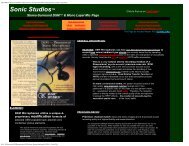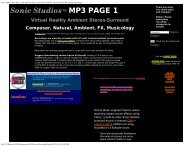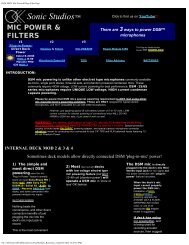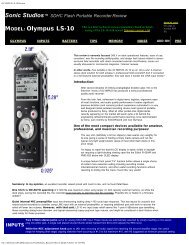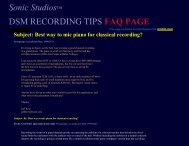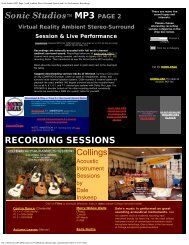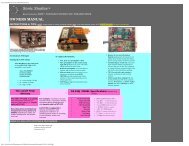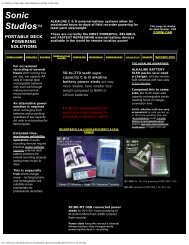Downloadable - Sonic Studios
Downloadable - Sonic Studios
Downloadable - Sonic Studios
Create successful ePaper yourself
Turn your PDF publications into a flip-book with our unique Google optimized e-Paper software.
motions to check the deck's VU are not usually noticeable. Quiet clothing (cotton is best) and wearing no loose, noisy jewelry is highly<br />
recommended. Keeping people directly adjacent from audibly talking, rustling paper programs, making squeaky chair noises, and<br />
jingling jewelry items is a matter of luck and timing, or planning on having a buffer of people 'in the know' around the mic position to<br />
keep the peace.<br />
Getting some buffer distance from close-up audience noise is your best friend in most these situations.<br />
Obviously, using a HRTF baffle on a tripod stand up 8-15 feet in the air makes the most sense in the long run. This where mic position<br />
for best ambient mix while not being in the way of anything important are the only considerations for getting a good ambient sound.<br />
Regards in Sound & Music Recording, Leonard Lombardo<br />
Subject: Re: Concert Recording "Martian Wxx" writes: Date: Sun, 14 Jan 2001 13:50:13 GMT<br />
He he he ............ I tell ya what if i have to tape another concert with his darn Tree mic stand in the middle of the screen sticking<br />
out like a sore thumb, i am gonna SCREAM!!!<br />
Guy<strong>Sonic</strong> Reply: Views of any microphone has always been a logistical problem when dealing with live audience, Video/live TV<br />
broadcast, and Film productions where the line of site is best kept unobstructed. The live line-of-site audience situation may allow a<br />
little more flexibility in that ambient microphone position well above most seated views is usually not difficult to implement and<br />
moderate distances from even a head-sized all pitch-black colored HRTF mic baffle make this blend well from spectator views that<br />
might partially include it.<br />
A little known fact is the HRTF baffled mic need NOT be directly positioned stage center to get excellent results because of the way it<br />
works with the entire ambient and not just a portion. Acceptable mic positions that work well are those within one-third (total span of<br />
hall width distance) from the side walls. Best to keep the stage front-to-hall-back (or balcony) distance within the 50% to one-third<br />
from the actual edge of the sound stage. Closer to the stage is also OK, but you start to need to bring the mic position much closer to<br />
being centered with being close-in to the stage; best position is often a mix of hall acoustics and PA speaker (if any are used) dependent<br />
and what (if any) views-of-the-mic are deemed acceptable to the audience and certain video angles that may include it.<br />
--------<br />
truly there are two types of concerts and two types of recordings<br />
that which is a concert (101 piece instrument) and that which is a noisy rock band so that wasn't to well defined in this thread, as<br />
somebody's mics would crumble in the latter situation somehow i don't think you have to worry about somones jewlery being audible<br />
at a stones concert or for that matter even someone yelling for a medic :-)<br />
------<br />
Guy<strong>Sonic</strong> Reply: The 'sensitivity' rating (sound pressure to electrical output factor) of a suitable microphone and maximum SPL<br />
(sound pressure handling ability before the Mic's electrical signal distorts) are two definite considerations when choosing a suitable<br />
microphone. Sensitivity rating is an especially important factor when using most battery powered DAT/MD portables and Camcorder<br />
mic inputs as these are the first to overload; usually well before the mic itself reaches its maximum SPL.<br />
This is one of the main reasons there's DSM mic models spanning 8 sensitivity ranges. This is important for having optimum mic-deck<br />
SYSTEM performance that's guaranteed for particular 'ranges' of recording requirements. Having the most versatile 'single' DSM or<br />
any microphone model is often a choice of knowing the likely loudest requirement and choosing this model appropriate to work with a<br />
particular recording SYSTEM.



